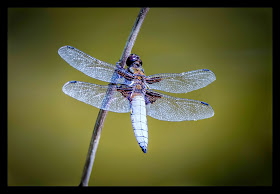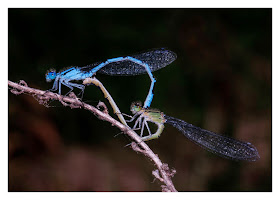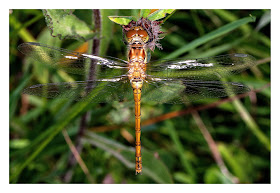June is always a quiet month for me as far as birding goes. Usually I spend a couple of days searching for a few migrants that I may have missed earlier, Quail likely as not, or I travel after a couple of enticing rare species. I quite fancied having a look at the Short-toed Eagle in Ashdown Forest but I couldn't summon up the enthusiasm for the drive. I didn't even have the get-up and go to get-up and go for the Spectacled Warbler in north Norfolk. Instead I have been concentrating on photographing insects and wild flowers in south-east Notts. Having sub-titled this blog 'A Birding Miscellany' I suppose I should stick to birdy matters but I think I have the option of veering off from time-to-time; especially when I have no bird related matter to share.
So here we have a selection of dragonfly shots all taken at Naturescape Wildflower Farm in Langar, Notts.
.jpgweb.jpg) |
| Broad-bodied Chaser Libellua depressa |
There is a pond that has been created specifically to entice dragonflies to breed and the designers certainly knew their business. I have seen and photographed seven species of dragonfly during two morning sessions. The most common is the Azure Damselfly with more than 50 of these floating about in the meadows that surrounds the pond.
.jpgweb.jpg) |
| Common Blue Damselfly Enallagma cyathigerum . Mating pair in wheel position |
Common Blue Damselflies are not, surprisingly, as common as the Azure but they are present in good numbers also in the surrounding meadow and flower fields.
.jpgweb.jpg) |
| Common Darter Sympetrum striolatum |
Common Darters were present in small numbers and these were relatively easy to photograph as they allowed a close approach and they tended to stay away from the water, resting on reeds and sedges and tall grasses in quite conspicuous places. Unlike the Emperor Dragonflies which never settled anywhere!
-Edit.jpgweb.jpg) |
| Emperor Dragonfly Anax imperator |
These big dragonflies were constantly on the move patrolling the pond. They had a set route but were erratic and unreliable in flight making it a difficult task to photograph them. Hence the blurry photographs of this species. Females often settled on floating vegetation so that they could lay their eggs onto submerged plants and occasionally the insects fell into the water and floundered around until they managed to get a hold of some floating stuff and pull themselves out. I took a few photographs of these dragonflies in the water but although they are sharp and well exposed they are not really aesthetically pleasing!
-Editweb.jpg) |
| Emperor Dagonfly Anax imperator |
Unlike this Four-spotted Chaser which was glistening and glinting in the sunlight. I only saw one individual of this insect but there may well have been more lurking on the far side of the pond. Close-up this is a stunning insect; all subtle golds and bronze.
 |
| Four-spotted Chaser Libulla quadrimaculata |
-Edit.jpgweb.jpg) |
| Azure Damselfly Coenagrion puella |
This Azure Damselfly, a male, is identified by the U-shaped black mark on the second segment of its abdomen. It can be seen here just beneath the wings where they attach to the body. You have to get close views to be certain to separate them from Common Blue Damselflies. The Banded Demoiselle, on the other hand, is distinctive from a good distance away.
.jpgweb.jpg) |
| Banded Demoiselle Calopteryx splendens |
.jpgweb.jpg) |
| Broad-bodied Chaser Libellula depressa |
.jpgweb.jpg)
.jpgweb.jpg)
.jpgweb.jpg)
-Edit.jpgweb.jpg)
-Editweb.jpg)

-Edit.jpgweb.jpg)
.jpgweb.jpg)
.jpgweb.jpg)





